Calibration of METRIC Model to Estimate Energy Balance over a Drip-Irrigated Apple Orchard
Abstract
:1. Introduction
Original METRIC Model
2. Materials and Methods
2.1. Study Area
2.2. Plant Measurements
2.3. Weather Data for ETr-PM Estimation
2.4. Energy Balance Component Measurements
2.5. Data Quality Control and Post-Processing
2.6. Satellite Images and Processing Procedure
2.7. Calibration of LAI, Zom and Gi Functions
2.8. Model Validation
3. Results and Discussion
3.1. Climatic and Crop Conditions
3.2. Validation of the Original and Calibrated Sub-Models of LAI and Zom
3.3. Validation of Orchard Energy Balance Fluxes
3.4. Distribution of Energy Balance into the Apple Orchard
4. Conclusions
Acknowledgments
Author Contributions
Conflicts of Interest
References
- Allen, R.G.; Pereira, L.S.; Raes, D.; Smith, M. Crop Evapotranspiration—Guidelines for Computing Crop Water Requirements—FAO Irrigation and Drainage Paper 56; FAO: Rome, Italy, 1998. [Google Scholar]
- Task Committee on Standardization of Reference Evapotranspiration. The ASCE Standarized Reference Evapotranspiration Equation; Report of the ASCE-EWRI; ASCE-EWRI: Kimberly, ID, USA, 2005; p. 147. [Google Scholar]
- Allen, R.G.; Pereira, L.S.; Howell, T.A.; Jensen, M.E. Evapotranspiration information reporting: I. Factors governing measurement accuracy. Agric. Water Manag. 2011, 98, 899–920. [Google Scholar] [CrossRef]
- Ortega-Farías, S.; Cuenca, R.; English, M. Hourly Grass Evapotranspiration in Modified Maritime Environment. J. Irrig. Drain. Syst. 1995, 121, 369–373. [Google Scholar] [CrossRef]
- Ortega-Farías, S.; Irmak, S.; Cuenca, R.H. Special issue on evapotranspiration measurement and modeling. Irrig. Sci. 2009, 28, 1–3. [Google Scholar] [CrossRef]
- Allen, R.; Irmak, A.; Trezza, R.; Hendrickx, J.M.H.; Bastiaanssen, W.; Kjaersgaard, J. Satellite-based ET estimation in agriculture using SEBAL and METRIC. Hydrol. Process. 2011, 25, 4011–4027. [Google Scholar] [CrossRef]
- López-Olivarí, R.; Ortega-Farías, S. Partitioning of net radiation and evapotranspiration over a superintensive drip-irrigated olive orchard. Irrig. Sci. 2016, 34, 17–31. [Google Scholar] [CrossRef]
- Cruz-Blanco, M.; Lorite, I.J.; Santos, C. An innovative remote sensing based reference evapotranspiration method to support irrigation water management under semi-arid conditions. Agric. Water Manag. 2014, 131, 135–145. [Google Scholar] [CrossRef]
- Anderson, M.C.; Allen, R.G.; Morse, A.; Kustas, W.P. Use of Landsat thermal imagery in monitoring evapotranspiration and managing water resources. Remote Sens. Environ. 2012, 122, 50–65. [Google Scholar] [CrossRef]
- Karimi, P.; Bastiaanssen, W.G.M.; Sood, A.; Hoogeveen, J.; Peiser, L.; Bastidas-Obando, E.; Dost, R.J. Spatial evapotranspiration, rainfall and land use data in water accounting—Part 2: Reliability of water accounting results for policy decisions in the Awash Basin. Hydrol. Earth Syst. Sci. 2015, 19, 533–550. [Google Scholar] [CrossRef]
- Karimi, P.; Bastiaanssen, W.G.M. Spatial evapotranspiration, rainfall and land use data in water accounting—Part 1: Review of the accuracy of the remote sensing data. Hydrol. Earth Syst. Sci. 2015, 19, 507–532. [Google Scholar] [CrossRef]
- Bastiaanssen, W.G.M. Remote Sensing in Water Resources Management: The State of the Art; International Water Management Institute: Colombo, Sri Lanka, 1998. [Google Scholar]
- Barbagallo, S.; Consoli, S.; Russo, A. A one-layer satellite surface energy balance for estimating evapotranspiration rates and crop water stress indexes. Sensors 2009, 9, 1–21. [Google Scholar] [CrossRef] [PubMed]
- González-Dugo, M.; Gonzalez-Piqueras, J.; Campos, I.; Balbontin, C.; Calera, A. Estimation of surface energy fluxes in vineyard using field measurements of canopy and soil temperature. Remote Sens. Hydrol. 2012, 352, 59–62. [Google Scholar]
- Consoli, S.; Vanella, D. Comparisons of satellite-based models for estimating evapotranspiration fluxes. J. Hydrol. 2014, 513, 475–489. [Google Scholar] [CrossRef]
- Allen, R.G.; Tasumi, M.; Trezza, R. Satellite-Based energy balance for Mapping Evapotranspiration with Internalized Calibration (METRIC)—Model. J. Irrig. Drain. Eng. 2007, 133, 380–394. [Google Scholar] [CrossRef]
- Allen, R.G.; Trezza, R.; Tasumi, M.; Kjaersgaard, J. METRIC: Mapping Evapotranspiration at High Resolution—Applications Manual for Landsat Satellite Imagery; Version 2.0.8; University of Idaho: Kimberly, ID, USA, 2012. [Google Scholar]
- Carrasco-Benavides, M.; Ortega-Farías, S.; Lagos, L.; Kleissl, J.; Morales-Salinas, L.; Kilic, A. Parameterization of the satellite-based model (METRIC) for the estimation of instantaneous surface energy balance components over a drip-Irrigated vineyard. Remote Sens. 2014, 6, 11342–11371. [Google Scholar] [CrossRef]
- Gowda, P.; Chávez, J.; Colaizzi, P.; Evett, S.; Howell, T.; Tolk, J. ET mapping for agricultural water management: Present status and challenges. Irrig. Sci. 2008, 26, 223–237. [Google Scholar] [CrossRef]
- Liou, Y.-A.; Kar, S. Evapotranspiration estimation with remote sensing and various surface energy balance algorithms—A Review. Energies 2014, 7, 2821–2849. [Google Scholar] [CrossRef]
- Carrasco-Benavides, M.; Ortega-Farías, S.; Lagos, L.O.; Kleissl, J.; Morales, L.; Poblete-Echeverría, C.; Allen, R.G. Crop coefficients and actual evapotranspiration of a drip-irrigated Merlot vineyard using multispectral satellite images. Irrig. Sci. 2012, 30, 485–497. [Google Scholar] [CrossRef]
- Pôças, I.; Paço, T.A.; Cunha, M.; Andrade, J.A.; Silvestre, J.; Sousa, A.; Santos, F.L.; Pereira, L.S.; Allen, R.G. Satellite-based evapotranspiration of a super-intensive olive orchard: Application of METRIC algorithms. Biosyst. Eng. 2014, 128, 69–81. [Google Scholar] [CrossRef]
- Santos, C.; Lorite, I.J.; Allen, R.G.; Tasumi, M. Aerodynamic parameterization of the satellite-based energy balance (METRIC) model for ET estimation in rainfed olive orchards of Andalusia, Spain. Water Resour. Manag. 2012, 26, 3267–3283. [Google Scholar] [CrossRef]
- Hankerson, B.; Kjaersgaard, J.; Hay, C. Estimation of evapotranspiration from fields with and without cover crops using remote sensing and in situ methods. Remote Sens. 2012, 4, 3796–3812. [Google Scholar] [CrossRef]
- Mokhtari, M.H.; Ahmad, B.; Hoveidi, H.; Busu, L. Sensitivity analysis of METRIC–Based evapotranspiration algorithm. Int. J. Environ. Res. 2013, 7, 407–422. [Google Scholar]
- Lu, J.; Tang, R.; Tang, H.; Li, Z.-L. Derivation of daily evaporative fraction based on temporal variations in surface temperature, air temperature, and net radiation. Remote Sens. 2013, 5, 5369–5396. [Google Scholar] [CrossRef]
- Ortega-Farias, S.; Poblete, C.; Brisson, N. Parameterization of a two-layer model for estimating vineyard evapotranspiration using meteorological measurements. Agric. For. Meteorol. 2010, 150, 276–286. [Google Scholar] [CrossRef]
- Bastiaanssen, W.G.M. SEBAL-based sensible and latent heat fluxes in the irrigated Gediz Basin, Turkey. J. Hydrol. 2000, 229, 87–100. [Google Scholar] [CrossRef]
- Singh, R.K.; Irmak, A. Treatment of anchor pixels in the METRIC model for improved estimation of sensible and latent heat fluxes. Hydrol. Sci. J. 2011, 56, 895–906. [Google Scholar] [CrossRef]
- Poblete-Echeverría, C.; Ortega-Farias, S. Evaluation of single and dual crop coefficients over a drip-irrigated Merlot vineyard (Vitis vinifera L.) using combined measurements of sap flow sensors and eddy covariance system. Aust. J. Vitic. 2013, 19, 249–260. [Google Scholar]
- Colombo, R.; Bellingeri, D.; Fasolini, D.; Marino, C.M. Retrieval of leaf area index in different vegetation types using high resolution satellite data. Remote Sens. Environ. 2003, 86, 120–131. [Google Scholar] [CrossRef]
- Webb, E.; Pearman, G.; Leuring, R. Correction of the flux measurements for density effects due to heat and water vapour transfer. Q. J. R. Meteorol. Soc. 1980, 106, 85–100. [Google Scholar] [CrossRef]
- Schotanus, P.; Nieuwstadt, F.; De Bruin, H. Temperature measurements with a sonic anemometer and its applications to heat and moisture fluxes. Bound. Layer Meteorol. 1993, 26, 81–93. [Google Scholar] [CrossRef]
- Wilczak, J.; Oncley, S.; Stage, S.A. Sonic anemometer Tilt correction algorithms. Bound. Layer Meteorol. 2001, 99, 127–150. [Google Scholar] [CrossRef]
- Payero, J.; Neale, C.; Wright, J. Estimating soil heat flux for alfalfa and clipped tall fescue grass. Am. Soc. Agric. Eng. 2005, 21, 401–409. [Google Scholar] [CrossRef]
- Raupach, M.R. Drag and drag partition on rough surfaces. Bound. Layer Meteorol. 1992, 60, 375–395. [Google Scholar] [CrossRef]
- Chen, Q.; Jia, L.; Hutjes, R.; Menenti, M. Estimation of aerodynamic roughness length over oasis in the Heihe river basin by utilizing remote sensing and ground data. Remote Sens. 2015, 7, 3690–3709. [Google Scholar] [CrossRef]
- Martínez-Cob, A.; Faci, J.M. Evapotranspiration of an hedge-pruned olive orchard in semiarid area of NE Spain. Agric. Water Manag. 2010, 97, 410–418. [Google Scholar] [CrossRef]
- Poblete-Echeverría, C.; Ortega-Farias, S. Calibration and validation of a remote sensing algorithm to estimate energy balance components and daily actual evapotranspiration over a drip-irrigated Merlot vineyard. Irrig. Sci. 2012, 30, 537–553. [Google Scholar] [CrossRef]
- Twine, T.; Kustas, W.; Norman., J.; Cook, D.; Houser, P.; Meyer, T.; Prueger, J.; Starks, P.; Wesely, M. Correcting eddy-covariance flux underestimates over a grassland. Agric. For. Meteorol. 2000, 103, 279–300. [Google Scholar] [CrossRef]
- Perrier, A. Land surface processes: Vegetation. In Land Surface Processes in Atmospheric General Circulation Models; Eagelson, P.S., Ed.; Cambridge University Press: Cambridge, UK, 1982; pp. 395–448. [Google Scholar]
- Mayer, D.G.; Butler, D.G. Statistical validation. Ecol. Model. 1993, 68, 21–32. [Google Scholar] [CrossRef]
- Willmott, C.J.; Ackleson, S.G.; Davis, R.E.; Feddma, J.J.; Klink, K.M.; Legates, D.R.; O’Donell, J.; Rowe, C.M. Statistics for the evaluation and comparison of models. J. Geophys. Res. 1985, 90, 8995–9005. [Google Scholar] [CrossRef]
- O’Connell, M.G.; Goodwin, I. Responses of “pink lady” apple to deficit irrigation and partial rootzone drying: Physiology, growth, yield, and fruit quality. Aust. J. Agric. Res. 2007, 58, 1068–1076. [Google Scholar] [CrossRef]
- Oliver, H.R.; Sene, K.J. Energy and water balances of developing vines. Agric. For. Meteorol. 1992, 61, 167–185. [Google Scholar] [CrossRef]
- Laubach, J.; Teichmann, U. Surface energy budget variability: A case study over grass with special regard to minor inhomogeneities in the source area. Theor. Appl. Climatol. 1999, 62, 9–24. [Google Scholar] [CrossRef]
- Kordova-Biezuner, L.; Mahrer, I.; Schwartz, C. Estimation of actual evapotranspiration from vineyard by utilizing eddy correlation method. Acta Hortic. 2000, 537, 167–175. [Google Scholar] [CrossRef]
- Testi, L.; Villalobos, F.J.; Orgaz, F. Evapotranspiration of a young irrigated olive orchard in southern Spain. Agric. For. Meteorol. 2004, 121, 1–18. [Google Scholar] [CrossRef]
- Ortega-Farias, S.; Carrasco, M.; Olioso, A.; Acevedo, C.; Poblete, C. Latent heat flux over Cabernet Sauvignon vineyard using the Shuttleworth and Wallace model. Irrig. Sci. 2007, 25, 161–170. [Google Scholar] [CrossRef]
- Hall, A.; Louis, J.P.; Lamb, D.W. Low-resolution remotely sensed images of wine grape vineyards map spatial variability in planimetric canopy area instead of leaf area index. Aust. J. Grape Wine Res. 2008, 14, 9–17. [Google Scholar] [CrossRef]
- Samani, A.; Bawazir, S. Improving Evapotranspiration Estimation Using Remote Sensing Technology; Technical Completion Report, Account Number (Index #): 125548; New Mexico Water Resources Research Institute: Las Cruces, NM, USA, 2015; p. 28. [Google Scholar]
- González-Dugo, M.P.; González-Piqueras, J.; Campos, I.; Andréu, A.; Balbontín, C.; Calera, A. Evapotranspiration monitoring in a vineyard using satellite-based thermal remote sensing. Proc. SPIE 2012. [Google Scholar] [CrossRef]
- Bastiaanssen, W.G.M.; Pelgrum, H.; Soppe, R.W.O.; Allen, R.G.; Thoreson, B.P.; Teixeira, A.H.d.C. Thermal infrared technology for local and regional scale irrigation analysis in horticultural systems. ISHS Acta Hortic. 2008, 792, 33–46. [Google Scholar] [CrossRef]
- Kamble, B.; Irmak, A.; Martin, D.L.; Hubbard, K.G.; Ratcliffe, I.; Hergert, G.; Narumalani, S.; Oglesby, R.J. Satellite-Based energy balance approach to assess riparian water use. In Evapotranspiration—An Overview; Alexandris, S.G., Stricevic, R., Eds.; InTech: Rijeka, Croatia, 2013. [Google Scholar]
- Ortega-Farías, S.; López-Olivarí, R. Validation of a two-layer model to estimate latent heat flux and evapotranspiration in a drip-irrigated olive orchard. Am. Soc. Agric. Biol. Eng. 2012, 55, 1169–1178. [Google Scholar] [CrossRef]
- Ortega-Farías, S.; Ortega-Salazar, S.; Poblete, T.; Kilic, A.; Allen, R.; Poblete-Echeverría, C.; Ahumada-Orellana, L.; Zuñiga, M.; Sepúlveda, D. Estimation of energy balance components over a drip-irrigated olive orchard using thermal and multispectral cameras placed on a helicopter-based unmanned aerial vehicle (UAV). Remote Sens. 2016, 8, 638. [Google Scholar] [CrossRef]

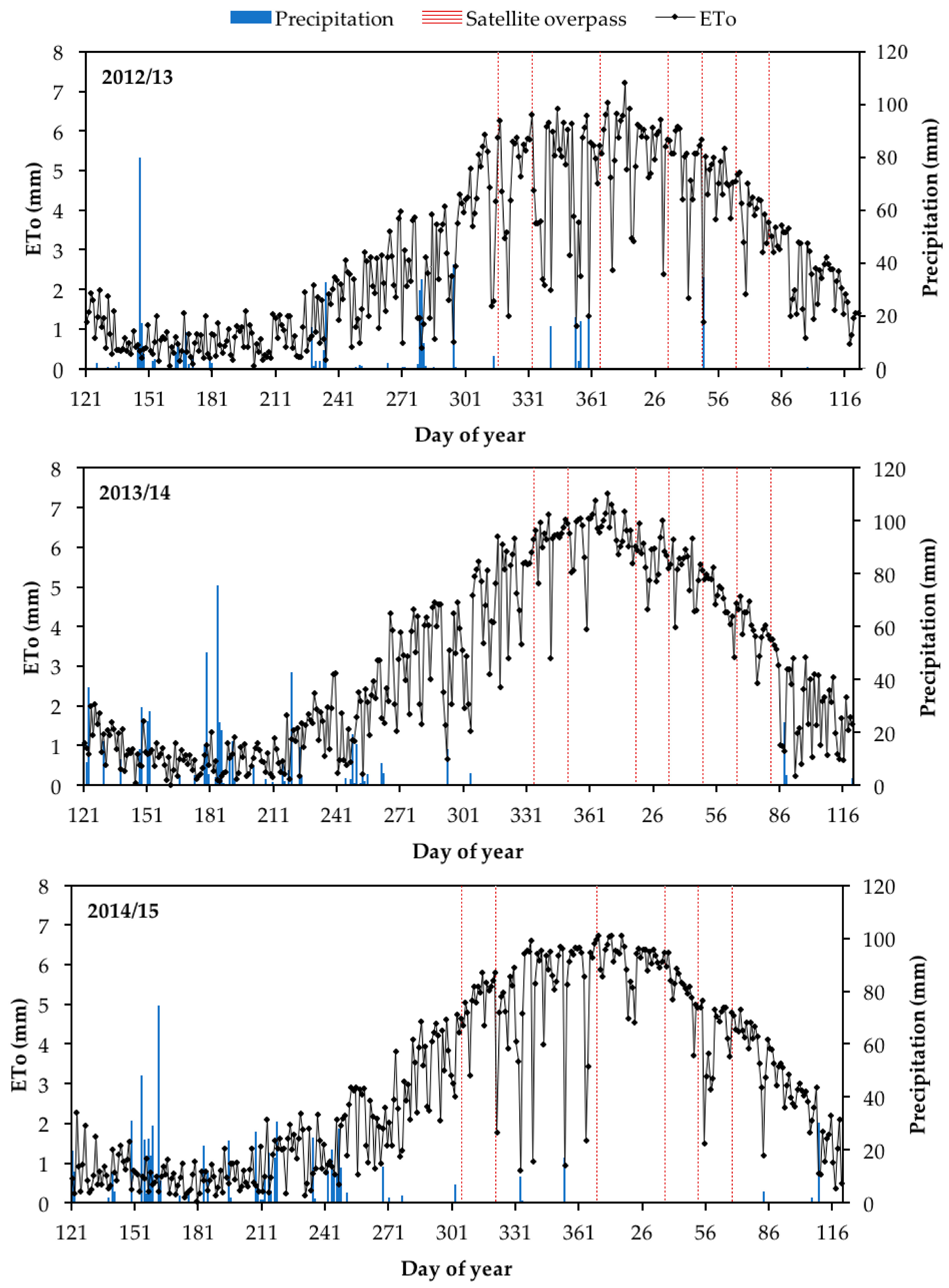

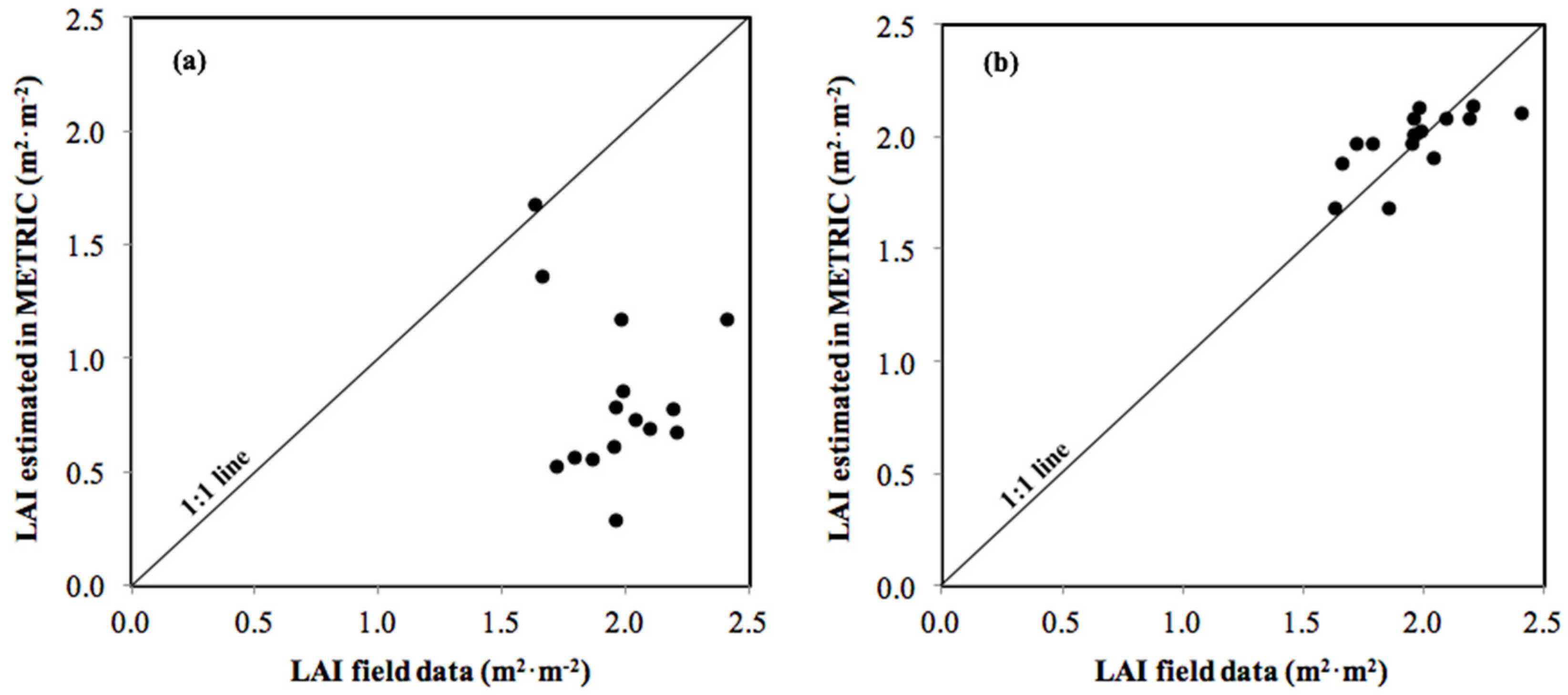
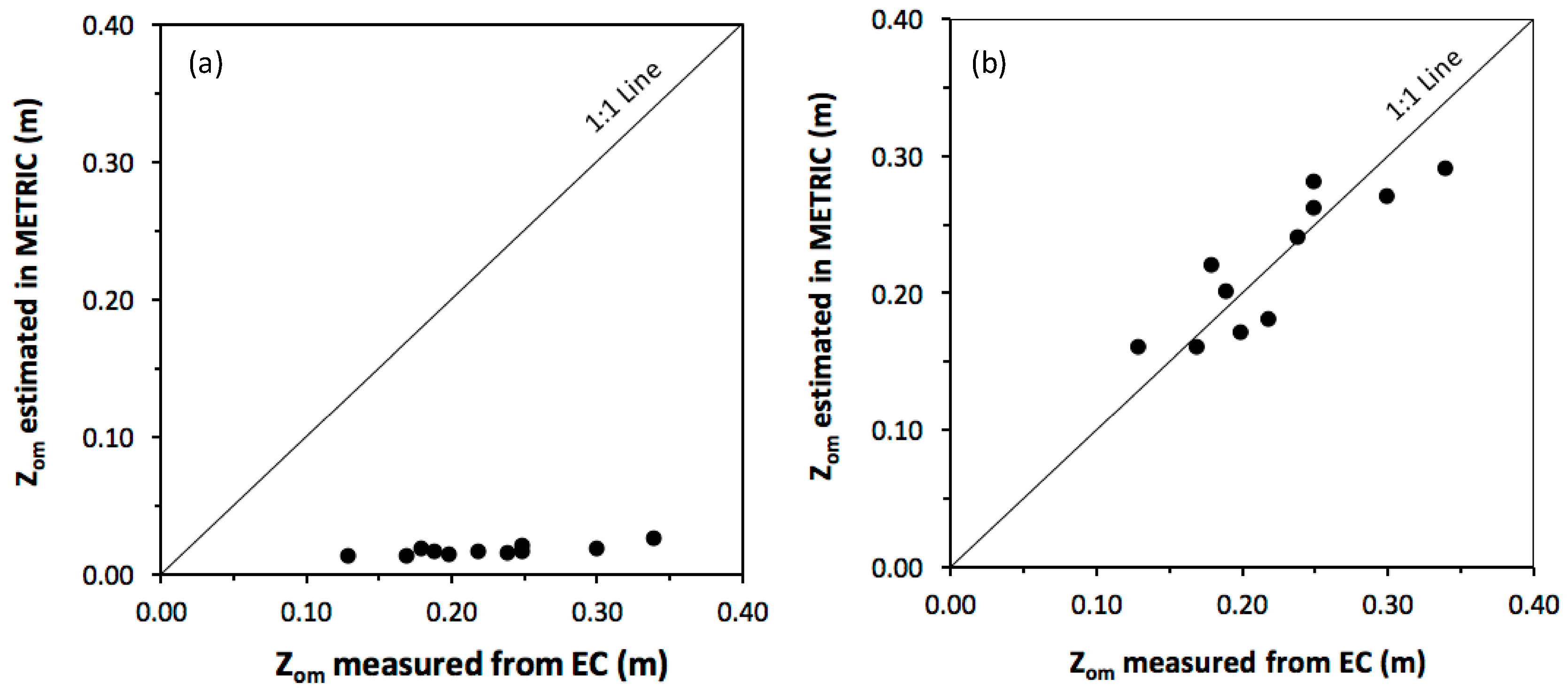
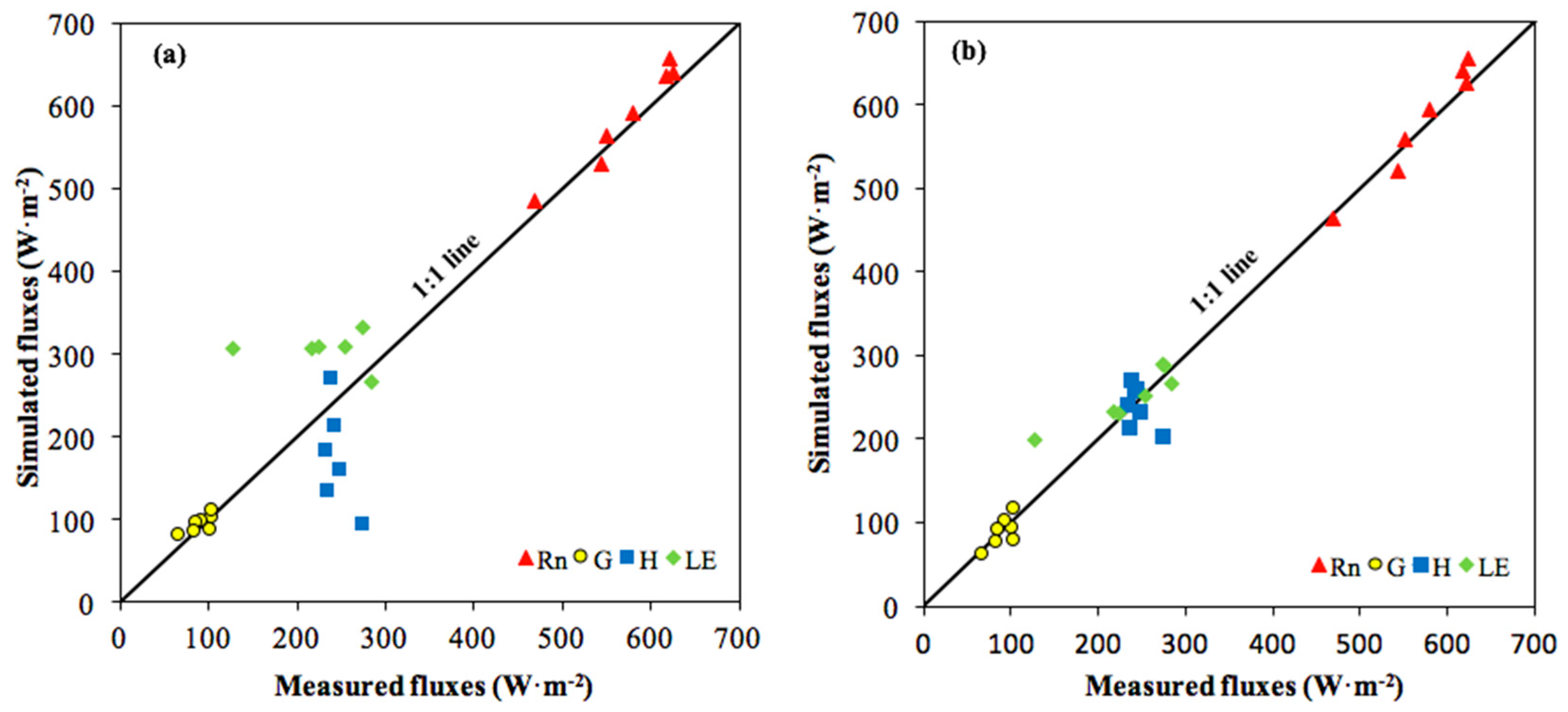
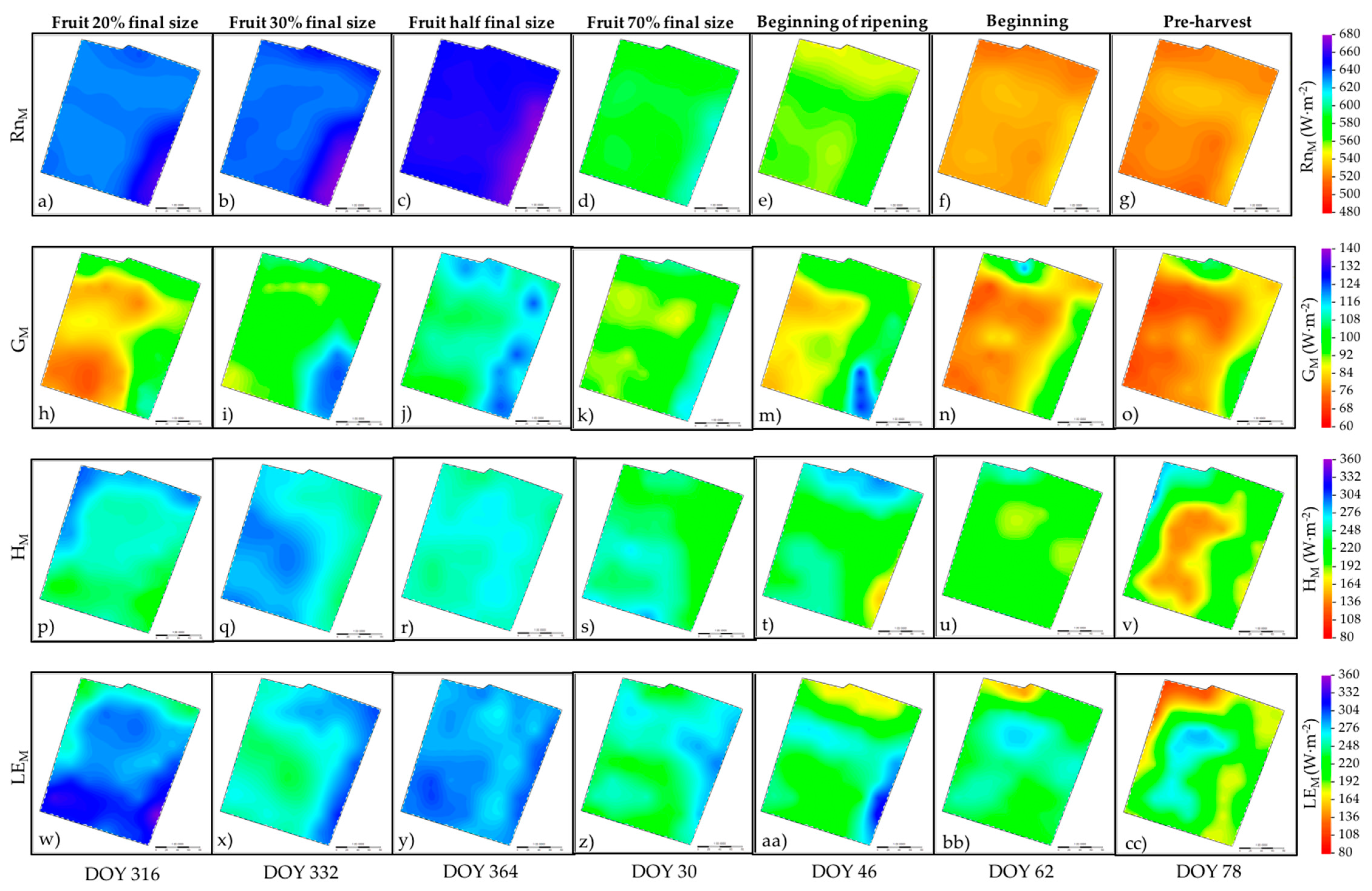
| Date | Day of Year (DOY) | Local Acquisition Time | Cloud Cover | |
|---|---|---|---|---|
| Validation set | 11 November 2012 | 316 | 11:30:22 | 1% |
| 27 November 2012 | 332 | 11:30:27 | 1% | |
| 29 December 2012 | 364 | 11:30:33 | 1% | |
| 30 January 2013 | 30 | 11:30:40 | 2% | |
| 15 February 2013 | 46 | 11:30:40 | 1% | |
| 3 March 2013 | 62 | 11:30:37 | 11% | |
| 19 March 2013 | 78 | 11:30:34 | 6% | |
| Calibration set | 30 November 2013 | 334 | 11:30:46 | 7% |
| 16 December 2013 | 350 | 11:30:47 | 4% | |
| 17 January 2014 | 17 | 11:31:05 | 26% | |
| 2 February 2014 | 33 | 11:31:21 | 6% | |
| 18 February 2014 | 49 | 11:31:09 | 2% | |
| 6 March 2014 | 65 | 11:31:16 | 0% | |
| 22 March 2014 | 81 | 11:31:26 | 0% | |
| Calibration set | 1 November 2014 | 305 | 11:32:28 | 1% |
| 17 November 2014 | 321 | 11:32:42 | 16% | |
| 4 January 2015 | 4 | 11:33:00 | 3% | |
| 5 February 2015 | 36 | 11:33:10 | 0% | |
| 21 February 2015 | 52 | 11:33:15 | 11% | |
| 9 March 2015 | 68 | 11:33:21 | 0% |
| Using Recalibrated LAI, Zom and Gi Algorithms of METRIC | |||||
|---|---|---|---|---|---|
| Variable | RMSE | MAE | b | d | t-test |
| LAI vs. LAIw | 0.20 (m2·m-2) | 0.15 (m2·m−2) | 0.98 | 0.44 | T |
| Zom vs. Zom_i | 0.03 (m) | 0.03 (m) | 0.94 | 0.91 | T |
| RnE vs. Rni | 19 (W·m−2) | 18 (W·m−2) | 1.02 | 0.97 | T |
| GE vs. GC | 16 (W·m−2) | 14 (W·m−2) | 0.97 | 0.84 | F |
| Hβ vs. Hi | 33 (W·m-2) | 26 (W·m−2) | 1.05 | 0.16 | F |
| LEβ vs. LEi | 30 (W·m−2) | 20 (W·m−2) | 1.16 | 0.87 | F |
| Using Original LAI, Zom and Gi Algorithms of METRIC | |||||
|---|---|---|---|---|---|
| Variable | RMSE | MAE | b | d | t-test |
| LAI vs. LAIM | 1.24 (m2·m−2) | 1.16 (m2·m−2) | 0.41 | 0.16 | F |
| Zom_E vs. Zom_i | 0.22 (m) | 0.21 (m) | 0.17 | 0.30 | F |
| RnE vs. Rni | 15 (W·m−2) | 15 (W·m−2) | 1.02 | 0.98 | T |
| GE vs. Gi | 33 (W·m−2) | 23 (W·m−2) | 1.12 | 0.74 | F |
| Hβ vs. Hi | 95 (W·m−2) | 80 (W·m−2) | 0.71 | 0.13 | F |
| LEβ vs. LEi | 95 (W·m−2) | 81 (W·m−2) | 1.26 | 0.38 | F |
© 2017 by the authors. Licensee MDPI, Basel, Switzerland. This article is an open access article distributed under the terms and conditions of the Creative Commons Attribution (CC BY) license (http://creativecommons.org/licenses/by/4.0/).
Share and Cite
De la Fuente-Sáiz, D.; Ortega-Farías, S.; Fonseca, D.; Ortega-Salazar, S.; Kilic, A.; Allen, R. Calibration of METRIC Model to Estimate Energy Balance over a Drip-Irrigated Apple Orchard. Remote Sens. 2017, 9, 670. https://doi.org/10.3390/rs9070670
De la Fuente-Sáiz D, Ortega-Farías S, Fonseca D, Ortega-Salazar S, Kilic A, Allen R. Calibration of METRIC Model to Estimate Energy Balance over a Drip-Irrigated Apple Orchard. Remote Sensing. 2017; 9(7):670. https://doi.org/10.3390/rs9070670
Chicago/Turabian StyleDe la Fuente-Sáiz, Daniel, Samuel Ortega-Farías, David Fonseca, Samuel Ortega-Salazar, Ayse Kilic, and Richard Allen. 2017. "Calibration of METRIC Model to Estimate Energy Balance over a Drip-Irrigated Apple Orchard" Remote Sensing 9, no. 7: 670. https://doi.org/10.3390/rs9070670







